Yes, it's hard to believe but we actually did more 'new stuff' than just the chekyns in sauce!?! This recipe...
¶For to make lesche frees.
¶To make lesche frees. take wardons & costardes boyled & bete them in a morter & drawe theym vp with malmsy & take harde yolkes & nesshe chese & bray them togeder & alay them with nesshe[?] yolk in the betynge & drawe it vp with malmsy & put it to the fruyte and put therto suger and pouder of canell & colour it with sanders & medle it wel togedr thanne couche thy comande in smale coffyns / and sette theym in an ouen to bake and when they be ressyn serue theym.
also saw the light of day.....and damned tasty it was too. Once again, there are larger versions of the pictures below over at Flickr for you to see, should you want a better look.
Reading through the recipe before the weekend, it looked like it was going to be a sort of cheesecake I suppose. The biggest problem was going to be the cheese though. With only a 2 day event we wouldn't have enough time to make the cheese from scratch so we'd have to make do with getting it from the supermarket along with some of the other ingredients we use.
In future, I'd like to try this recipe again but with a 'home made' (insert Palace for home here!) cheese rather than a commercial one.....but on this occasion beggars couldn't be choosers so we plumped for a soft cheese to try first...probably not an ideal choice, but I think the best we could hope to make under the circumstances.
The cheese sorted out and the rest of the ingredients not proving as problematic, we cracked on (by we, once again I mean Robin and Jorge whilst I lounged around taking pictures)
. take wardons & costardes boyled & bete them in a morter
So, taking pears, conference in this case and apples (from Robins tree)....varieties were not top priority for this attempt as this was more a 'proof of concept' recipe I suppose (also, Robin doesn't know the variety of apple tree he has as it came with the house when he bought it)...

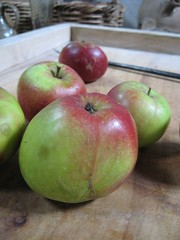
They were peeled and cut up to speed up the cooking, then plopped into the pot and cooked until soft before placing them into the mortar and giving them a beating they'll not soon forget.
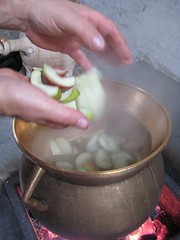

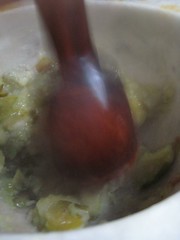
Once beaten to a pulp, some malmsey was added....a nice slug of Madeira had to suffice here (well ok, a little more than a slug) and the fruit mix was then set aside whilst the mortar was cleaned out ready for the next stage.
take harde yolkes & nesshe chese & bray them togeder & alay them with nesshe[?] yolk in the betynge & drawe it vp with malmsy & put it to the fruyte
While the mortar was being cleaned some eggs were put on to hard boil
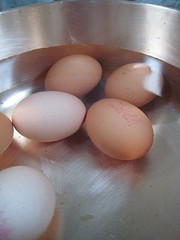
The eagle eyed amongst you will spot the modern stamps all over the eggs (a legal requirement for egg sellers today and one that proves to be a constant source of amusement to visitors.....'Didn't know old 'Enry had an ink jet to print on his eggs back then' and so on, you get the idea!)
Fist, the cheese was 'ground' up, then the hard yolks added and ground smooth...


Then more malmsey and some raw egg yolks were added...
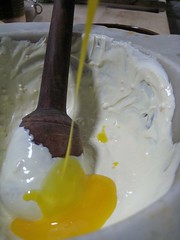

This is where it went a little wrong....nothing too drastic, just not enough raw egg was used so the end result was a little looser than it could have been...still, plenty of opportunities to try again and as I said earlier...more a 'proof of concept' than a finished dish, it was after all the first time we'd ever tried it and the first time that Robin and Jorge had ever seen the recipe!!
The next step was to add the cheese mix to the fruit.....
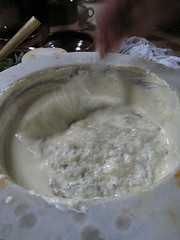
and then....
and put therto suger and pouder of canell & colour it with sanders & medle it wel togedr
add sugar and cassia to sweeten and spice the mix, which we did although it didn't need a whole lot of sugar to be honest..
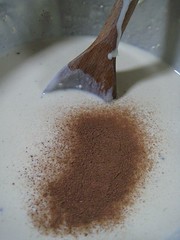
When it came to adding the colour, that I'm afraid was a bit of a failure....we just couldn't get any colour out of the saunders that we have, so we left that bit out (and have started to work on extracting a decent colour from saunders as a side project).
Finally
thanne couche thy comande in smale coffyns / and sette theym in an ouen to bake and when they be ressyn serue theym.
The fruity cheesy mix was poured into some blind baked cases and slammed in the oven until they had risen and taken on some colour....sorry, can't recall how long they were cooking for, but probably not too long (I know, I'm no help am I?)
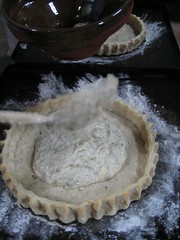
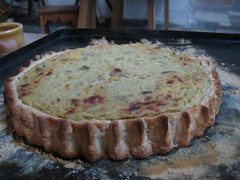
The taste? Great.....strangely enough it had a really familiar taste that reminded me of French pastries, but that was probably the Madeira combined with the fruit. Is it worth trying again....hell yes, we had problems keeping the guys from eating the raw mix as it was that good.....is it worth you all trying.....definitely!
That's all for now, more later on in the week I hope.

6 comments:
Sounds and looks yummy. Is this also from Pynsons 'The boke of cokery'? I'm not familiar with that source and Goggle is no help. Can you tell me more about it?
Thanks,
Donna in SF
Pah it's all favourtism with you isn't it come on own up what's the Porto bribed you with to keep me out YET AGAIN
=oÞ
Marc(marc who)
What cheese did you use in the end? You say "soft cheese" - in the photos it looks like cream cheese. I wonder if something like a ricotta might have given more solidity?
Donna,
Richard Pynson was a prolific printer in the early part of the 16th century, he was official printer to Henry VIII for some years, but I digress.
His print of the 'Boke of Cokery' printed in 1500 is the first printed and published cookery book in England and although it tends to be referred to as the Pynson book, the actual author remains annonymous.
There is only one surviving copy that is known of and that is owned by Lord Bath at Longleat house. Much work has been done on this book over recent years and it is expected that a re-print with accompanying essays will go on sale in the near future (although I have been told that many times over the last few years!)
There are a couple of microfilm versions of the book that are available in academic libraries and large collections such as the British Library, but their quality is poor to say the least.
Like many in the 'food history' world, I can't wait to see the re-printed version as it will open up the world of 'Tudor' food as never before I think.
Marc,
Don't fret matey....I'm just testing out the Western Spaniard to see when he breaks! Your time will come....possibly sooner than you think.
Kiriel,
As I said, we were somewhat limited with our choice of cheese and had to make do with a fairly soft cream cheese. Experience with both this same cheese and ricotta from the same suppliers has shown that once beaten in the mortar they end upo at very similar consistencies. More yolk is the answer as I think only 2 0r 3 at most went in which was nowhere near enough, but was all that were to hand at the time!
Thinking further on it, the recipe is also for small pies, and the ones you made look reasonably big. A smaller pie would set with less yolks than the larger one..
Two comments- a starchier baking apple would lower the liquid content but increase need for sugar.
Mascarpone and the lebanese labneh are soft cheeses that have richer flavor and would possibly be closer in flavor to a medieval fresh cheese.
Either way the recipe looks like a good addition to a late fall/winter feast especially as a tartlet.
Please post your attempts at working with sanders as I can't get decent colour out of it either.
Post a Comment